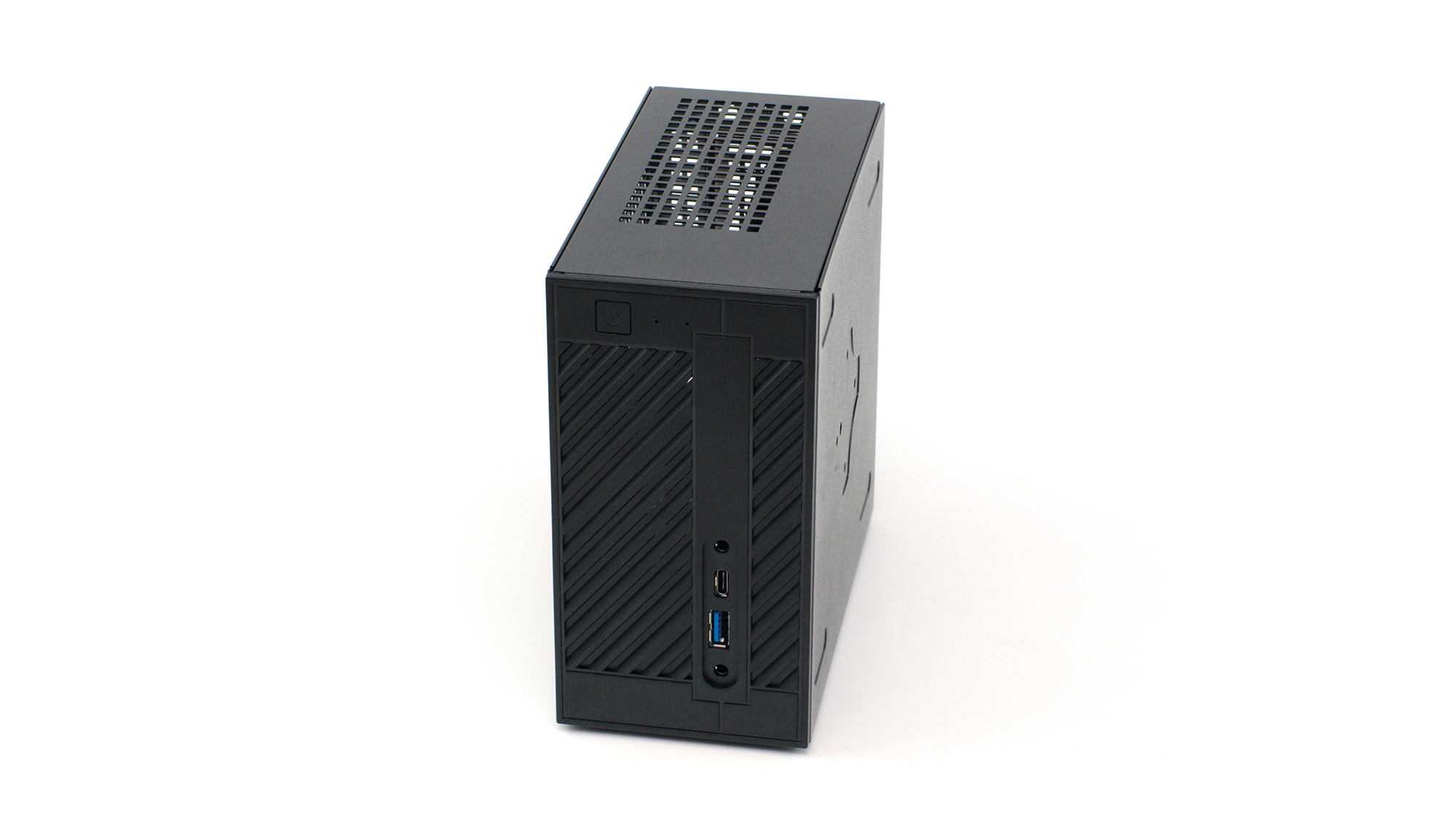ASRock DeskMini 310 Series review: Bigger on the inside
As close as you’ll get to a full-size PC without a full-size chassis – as long as you don’t need a discrete GPU

This compact ASRock system might not be as petite as some of its rivals, but a smart chassis design and powerful performance make it a good option for everyday duties - although beware the power consumption.
-
+
Great performance; Good internal design; Twin 2.5in SATA bays
-
-
One-year RTB warranty; High idle power draw; No discrete GPU

Most small-form-factor PCs force you to make some kind of compromise - usually in the area of performance. Space constraints often don't allow for adequate cooling, which means that CPU speeds are throttled to prevent overheating. In the case of this miniature marvel from ASRock, however, this is most certainly not the case.
ASRock DeskMini 310 Series review: Design
Robbed of any sense of scale, you would think the ASRock DeskMini 310 Series was a full-size tower PC; it's only when you spot the size of the USB ports, or get up close and personal with it in the flesh, that you realise it seems to have shrunk in the wash.
Based on the STX form factor, smaller even than ITX, the DeskMini is a true barebones system: as standard it comes with only the case, power supply and motherboard. Everything else must be purchased separately and fitted by hand, making it the only system on test to come without some form of specialised CPU cooler.
There's not a lot of clearance inside, either. The chassis can only take low-profile coolers, and the wider of these can foul a motherboard heatsink.
ASRock DeskMini 310 Series review: Specs and performance
Fitted with the recommended Noctua NH-L9i cooling (which is 38 including VAT from overclockers.co.uk), an Intel Core i5-8400 and 16GB of RAM, though, the DeskMini really shines. The case allows for an impressive amount of ventilation at an extremely low noise level - not as quiet as fanless systems like the QuietPC AMD Sentinel, but not something anyone could find objectionable.
With nowhere to fit a discrete GPU, performance is unsurprising - and effectively identical to the similarly specified Asus PB60. Having the flexibility to fit a range of processor types, though, means that it can be customised to fit a particular workload: fit a Core i7-8700 to get top performance from the motherboard, or a Pentium G5400T to tame the machine's 54.8W peak power draw as tested.
ASRock DeskMini 310 Series review: Ports and features
Idle power draw, sadly, isn't the DeskMini's strong suit: with the Core i5-8400 fitted, the machine refused to dip below 12.4W - higher than some of its (admittedly less powerful) rivals at load. More impressive is the case's ability to take two 2.5in SATA drives, which are tucked away on the rear of the removable motherboard tray.
Sign up today and you will receive a free copy of our Future Focus 2025 report - the leading guidance on AI, cybersecurity and other IT challenges as per 700+ senior executives
A single year's return-to-base warranty, though, is a little miserly in today's market, and (unless you choose a custom-build option) only covers the motherboard, chassis and external power supply.
ASRock DeskMini 310 Series review: Verdict
With surprisingly meaty performance for a barebones small-form-factor system, the ASRock DeskMini 310 Series is more than capable of handling the full range of office duties demanded from a workplace machine, and although it's not as space-efficient as some of the units we've seen, it's easily unobtrusive enough to slip out of sight under a desk or behind a monitor.
Verdict
This compact ASRock system might not be as petite as some of its rivals, but a smart chassis design and powerful performance make it a good option for everyday duties - although beware the power consumption.
| Processor | Intel Core i5-8400 |
| RAM | 16GB DDR4-2400 SODIMM |
| Front-facing USB ports | USB-A 3.1 Gen 1, USB-C 3.1 Gen 1 |
| Rear-facing USB ports | USB-A 3.1 Gen 1, USB-A 2 |
| Graphics card | Intel UHD Graphics 630 |
| Storage | 250GB, 2 x 2.5in SATA 3, microSD |
| Operating system | Windows 10 Pro |
| Warranty | 1yr RTB |
Gareth Halfacree is an experienced tech journalist and IT professional, and has been writing since 2006. In addition to contributing article for ITPro, Gareth has been featured in publications such as PC Pro, Techmeme, The Register, The MagPi, and Tom’s Hardware.
In addition to his digital articles, Gareth is the author of several best-selling books. These include the Raspberry Pi User Guide, an essential text for those looking to get started with their Raspberry Pi, as well as The Official Raspberry Pi Beginner’s Guide. Gareth also wrote the Official BBC micro:bit User Guide, a comprehensive guide to setting up the pocket-sized computer, learning to code on it, and even creating your own hardware addons.
-
 Amazon says Russian-backed threat groups were responsible for five-year-long attacks on edge devices – and it shows a ‘clear evolution in tactics’
Amazon says Russian-backed threat groups were responsible for five-year-long attacks on edge devices – and it shows a ‘clear evolution in tactics’News Russian-backed hacker groups are exploiting misconfigured edge devices – now preferring that tactic over hunting down traditional vulnerabilities to gain access to company networks.
By Nicole Kobie Published
-
 UK government confirms October cyber breach: Everything we know so far
UK government confirms October cyber breach: Everything we know so farNews Details around Foreign Office hack remain sparse and government says it's unclear who is behind the attack
By Nicole Kobie Published
-
 Data center investment reached a record $61 billion this year
Data center investment reached a record $61 billion this yearNews Hyperscaler expansion, private equity interest, and a surge in debt financing are behind skyrocketing investment levels
By Emma Woollacott Published
